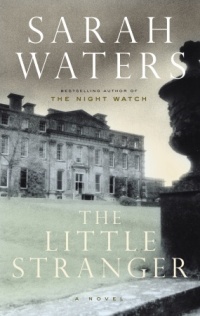This isn’t a formal review of Sarah Waters’ excellent new novel The Little Stranger, but you can consider it a strong recommendation. If you haven’t read Sarah Waters, she’s a British writer with a superb command of voice, cultural history, and the art of storytelling. Her first novel was Tipping the Velvet, an unputdownable tour of gender conventions and their bending in Victorian London. Her latest, The Little Stranger, is a ghost story set in a crumbling manor house in post-World-War-II Warwickshire.
Ghost stories are by nature delicate to write and difficult to resolve. To explain a haunting is to diminish its effect, but to leave it unexplained is to render it pointless. Waters walks this line confidently, and her sense of the eerie is impeccable—in part, perhaps, because she draws on that venerable source of all things ghostly, Catherine Crowe’s 1848 bestseller The Night Side of Nature. The Night Side of Nature was a compendium of anecdotal stories of the supernatural, so successful in its day that it entered into British and American folk culture as a seamless graft. That story Grandma told you about the clock that stopped when Uncle Amos died, or the dream that kept Aunt Violet off a doomed trolleycar? Odds are it’s a hand-me-down from The Night Side of Nature. Every such book since then (Hanz Holzer, Frank Edwards, et alia) is a direct descendant. Sarah Waters, in other words, knows where the scary stuff comes from, and she knows how to use it.
The Little Stranger has interesting things to say about the class system and human psychology; even better, it’s one of those rainy-windy-night books, a pull-up-the-covers-to-your-chin book, a leave-the-light-on-just-for-now book. You don’t come across such books very often, and you should treasure them when you do.
The Little Stranger left me thinking about ghosts and the houses they haunt. In Sarah Waters’ novel, and in most such stories, ghosts appear almost as an unintended consequence of architecture. (The narrator of The Little Stranger begins by stealing a piece of the house’s wainscoting, for example.) A forest or a mountain may be haunted, but by rather different spirits. A haunted glade is Pan’s territory. The haunted house is a more intimately human place.
Evolutionary psychology suggests that human beings have a tendency to perceive intent and motive in natural events. Children asked what a river is for will confidently tell you it’s “for boats to float on” or “for fish to live in.” In other words, we’re born with an intuitive animism. The storm is angry, the flower is happy, and the bosky dell is haunted.
But that’s nature, and we don’t much live in nature these days. I’m looking out my window as I write this, and everything I can see is a product of human activity or has been manipulated by it—the road, the mall, the river of traffic. There are trees, but they grow exclusively in the places human beings have chosen for them. The only raw and untouched thing I can see is the sky…and even that’s crosshatched with contrails. Familiarity blinds us to the strangeness of the way we’re enveloped and constrained by the products of human intellect. The house I live in began its existence as an act of symbolic imagination, a thought-made material, and not just one person’s thought: the architect who designed it was borrowing principles of construction and design from a chorus of dead men and women older than Archimedes. The hominid who first raised a hide roof is invisibly represented here. And in that sense, every house is haunted.
Which is why a haunted house is distinct from a haunted forest. In both cases we see menace or malice where none should exist; but in a world of made things, the invisible presence feels eerily human.
And that’s why the classic 1956 sf film Forbidden Planet might better be considered as a ghost story.
Forbidden Planet is remarkable for many things, not the least of which is Anne Francis and her pouting faux-innocent “Kiss? What is kiss?” dialogue. It plays like a really good classic Star Trek episode, with Leslie Neilsen standing in for William Shatner. The plot famously follows The Tempest, but Forbidden Planet‘s vanished race of Krell are a far cry from Shakespeare’s airy spirits. The Krell civilization is portrayed as having vanished at the moment of its crowning technological achievement—nothing less than a complete mastery of nature, a planetary power source that allows thought to be translated into matter without conscious volition.
The Krell, in other words, have completely colonized nature with mind. They have made of their world one vast expressed collective thought—only to discover that “mind” is an architecture stranger and more complex than they anticipated, and that unintended consequences and unacknowledged passions are built into even the best of blueprints.
It’s the same truth Sarah Waters leads us to in The Little Stranger. And maybe that’s the moral of any ghost story: what we make is inevitably haunted by our making of it.
Robert Charles Wilson
is the author of the Hugo-winning novel
Spin
. His new novel,
Julian Comstock: A Story of 22nd Century America
, is available now from Tor Books. You can read excerpts from his book
here
.











What I really like about this article is that even though I’m inundated with ideas for sf books to read on sites such as this and others, one thing I sometimes feel starved of is recommendations for books from *outside* the genre by people on the inside. Yes, it’s a ghost story, but it’s not written by someone in our little club of sf and fantasy, and more like this would be delightful.